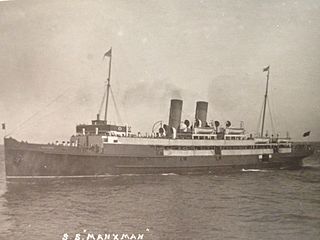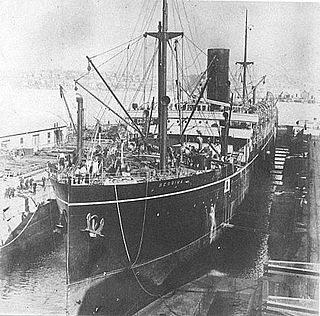
HMS Gorgon was a wooden steam paddle sloop of 6 guns, launched in 1837. In 1840 she took part in the bombardment of Acre, and in 1843 was part of the Royal Navy squadron stationed in the River Plate during the Uruguayan Civil War. She was converted to a troopship and in 1858 assisted Agamemnon in the laying of the first transatlantic telegraph cable. She was sold for breaking in 1864.

The City of Dublin Steam Packet Company was a shipping line established in 1823. It served cross-channel routes between Britain and Ireland for over a century. For 70 of those years it transported the mail. It was 'wound-up' by a select committee of the House of Lords in 1922 and finally liquidated in 1930.

PS Queen Victoria was a paddle steamer built for the City of Dublin Steam Packet Company in 1838 and wrecked in 1853 with the loss of more than 80 passengers and crew.

The USS Cherokee was a 606-ton screw steam gunboat in the US Navy during the American Civil War ship. The ship later served in the Chilean Navy.

HMS Himalaya was built for the Peninsular and Oriental Steam Navigation Company as SS Himalaya, a 3,438 gross register ton iron steam screw passenger ship. She was purchased by the Royal Navy in 1854 for use as a troopship until 1894 and was then moored in the Hamoaze, Devonport to serve as a Navy coal hulk until 1920, when sold off. She was sunk during a German air attack on Portland Harbour in 1940.

TSS Manxman was a turbine steamship launched in 1904 for the Midland Railway and operated between Heysham and Douglas, Isle of Man. In 1916, she was commissioned by the Royal Navy as HMS Manxman and saw action as a seaplane carrier during the First World War, after which she was acquired by the Isle of Man Steam Packet Company. On the outbreak of the Second World War she was again requisitioned as a troop ship, until she was commissioned and her name changed to HMS Caduceus. She never returned to Manx waters, and was scrapped in August 1949.

SS Sirius was a wooden-hulled sidewheel steamship built in 1837 by Robert Menzies & Sons of Leith, Scotland for the London-Cork route operated by the Saint George Steam Packet Company. The next year, she opened transatlantic steam passenger service when she was chartered for two voyages by the British and American Steam Navigation Company. By arriving in New York a day ahead of the Great Western, she is usually listed as the first holder of the Blue Riband, although the term was not used until decades later.

HMS Melita was a Royal Navy Mariner-class composite screw sloop of 8 guns, launched in 1888 and commissioned in 1892. She was the only significant Royal Navy warship ever to be built in Malta Dockyard, She was renamed HMS Ringdove in 1915 as a salvage vessel and in 1920 was sold to the Falmouth Docks Company, which changed her name to Ringdove's Aid. She was sold again in 1926 to the Liverpool & Glasgow Salvage Association, renamed Restorer, and finally broken up in 1937, 54 years after her keel was laid.

Caird & Company was a Scottish shipbuilding and engineering firm based in Greenock. The company was established in 1828 by John Caird when he received an order to re-engine Clyde paddle-tugs.
PS Norah Creina was a paddle steamship operated by the Drogheda Steam Packet Company from 1878 to 1902 and the Lancashire and Yorkshire Railway from 1902 to 1912.

SS or RMS The Ramsey was a passenger steamer operated by the Isle of Man Steam Packet Company from 1912 to 1914. She had been built in 1895 as Duke of Lancaster for the joint service to Belfast of the London and North Western Railway and Lancashire and Yorkshire Railway companies. The steamer was requisitioned by the Admiralty in 1914 as the armed boarding vessel HMS Ramsey and sunk the following year.
HMS Wizard was a 10-gun Cherokee-class brig-sloop built for the Royal Navy during the 1820s. She was wrecked in 1859.
HMS Peterel was a six-gun Alert-class packet brig built for the Royal Navy during the 1830s.

HMS Merlin was the name ship of her class of three 2-gun paddle packet boats built for the Royal Navy during the 1830s. She was converted into a survey ship in 1854 and then into a gunvessel two years later. The ship was decommissioned in 1858 and was sold into commercial service in 1863.
HMS Medina was a 2-gun Merlin-class paddle packet boat built for the Royal Navy during the 1830s. The ship remained in ordinary until she was commissioned in 1848. She was converted into a survey ship in 1856 and was broken up in March 1864.
HMS Medusa was one of three 2-gun Merlin-class paddle packet boat built for the Royal Navy during the 1830s. She was converted into a tugboat in 1861–1862 and sold for scrap in 1872.
Three ships of the British Royal Navy have been named Prospero for the Shakespearean character Prospero:
Water Witch was an early British wood-hulled paddle steamer, built in 1835 at Harwich, England for steam packet services from Dover to London and to Boulogne. A successful fast ship, she was later operated on services on the South Coast of England and in the Bristol Channel
The Britannia of 1815 was a wood-hulled British paddle steamer built at Port Glasgow for services on the Firth of Clyde. Later she ran between Glasgow and Derry. Britannia was wrecked at Donaghadee on 12 October 1829.










